Risk Management Plan: Analysis for Fonterra New Zealand (BS502001)
VerifiedAdded on 2022/11/14
|15
|3258
|384
Report
AI Summary
This report presents a comprehensive risk management plan for Fonterra New Zealand, a major dairy exporter. It identifies and describes four key risks: financial management, biosecurity, political (legal action), and economic risks, categorizing them as internal or external. The report analyzes the likelihood and potential consequences of each risk, assigning ratings based on impact and probability. It includes a detailed risk assessment framework, evaluating existing controls and proposing alternative solutions to mitigate identified risks. The analysis covers the risk management process, from identification to monitoring, and offers recommendations for improvement, including control assessments and strategies to minimize the impact of risks on Fonterra's operations. The report emphasizes the importance of proactive risk management in maintaining the company's financial health and operational efficiency.
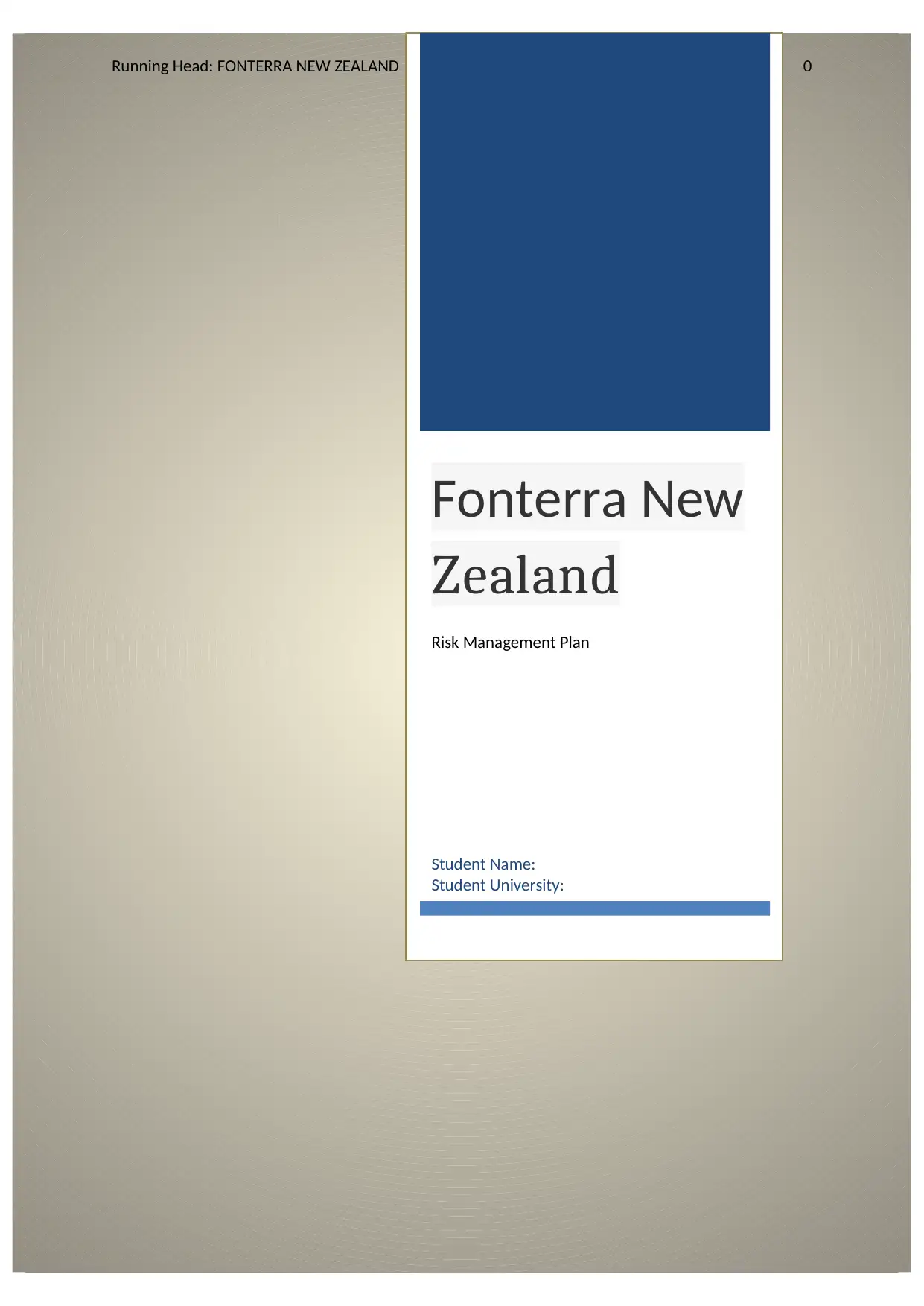
Running Head: FONTERRA NEW ZEALAND 0
Fonterra New
Zealand
Risk Management Plan
Student Name:
Student University:
Fonterra New
Zealand
Risk Management Plan
Student Name:
Student University:
Paraphrase This Document
Need a fresh take? Get an instant paraphrase of this document with our AI Paraphraser
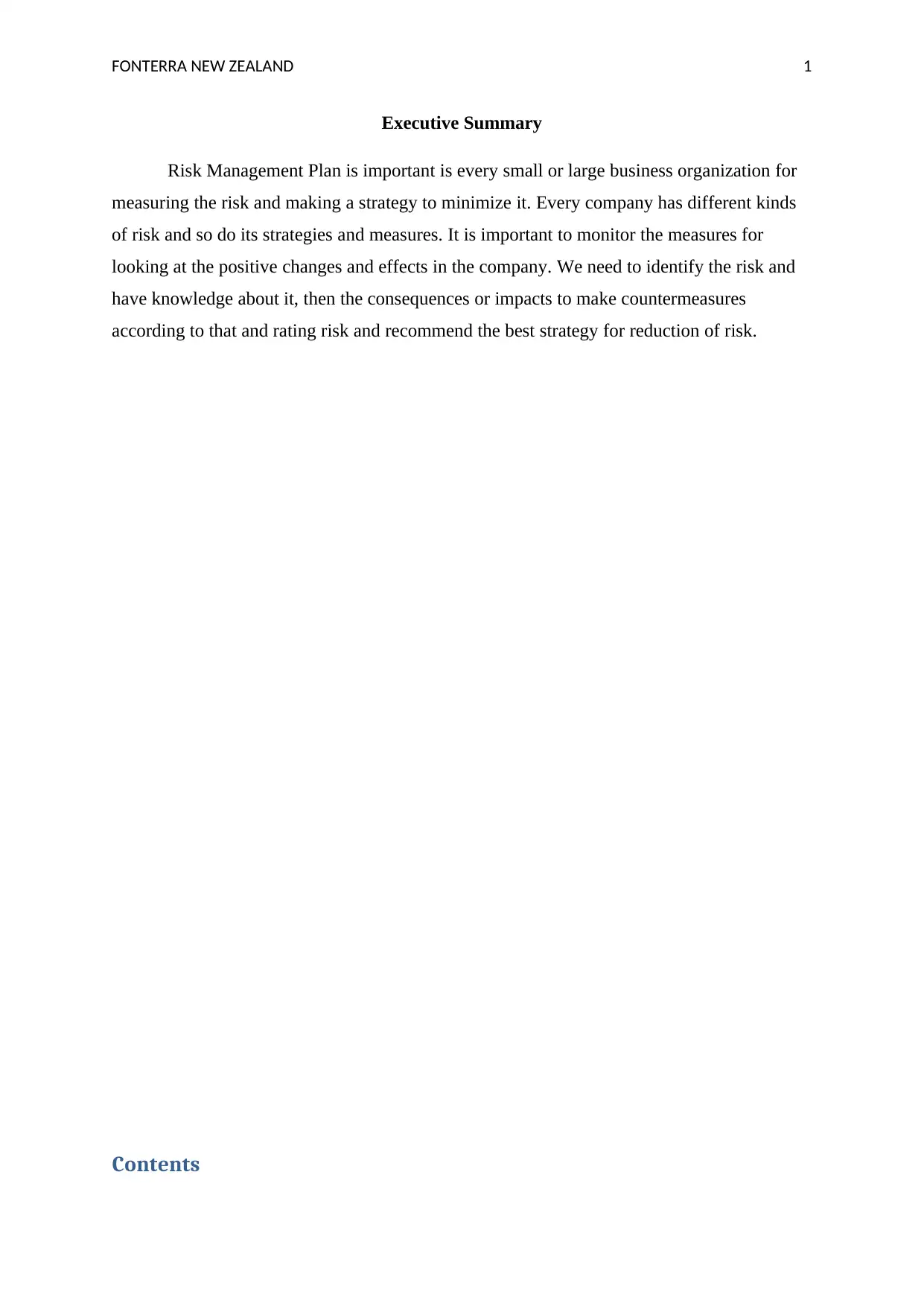
FONTERRA NEW ZEALAND 1
Executive Summary
Risk Management Plan is important is every small or large business organization for
measuring the risk and making a strategy to minimize it. Every company has different kinds
of risk and so do its strategies and measures. It is important to monitor the measures for
looking at the positive changes and effects in the company. We need to identify the risk and
have knowledge about it, then the consequences or impacts to make countermeasures
according to that and rating risk and recommend the best strategy for reduction of risk.
Contents
Executive Summary
Risk Management Plan is important is every small or large business organization for
measuring the risk and making a strategy to minimize it. Every company has different kinds
of risk and so do its strategies and measures. It is important to monitor the measures for
looking at the positive changes and effects in the company. We need to identify the risk and
have knowledge about it, then the consequences or impacts to make countermeasures
according to that and rating risk and recommend the best strategy for reduction of risk.
Contents
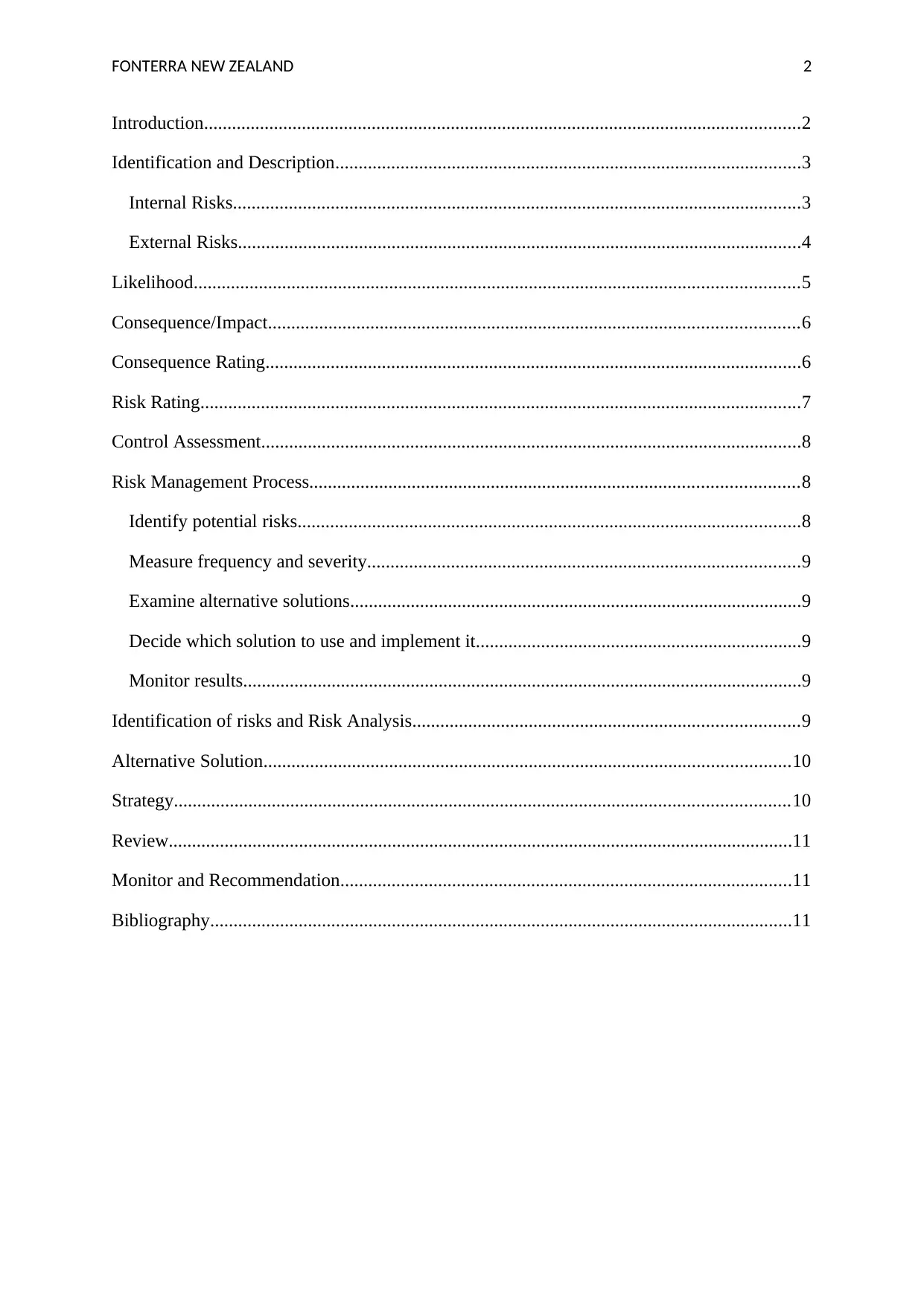
FONTERRA NEW ZEALAND 2
Introduction................................................................................................................................2
Identification and Description....................................................................................................3
Internal Risks..........................................................................................................................3
External Risks.........................................................................................................................4
Likelihood..................................................................................................................................5
Consequence/Impact..................................................................................................................6
Consequence Rating...................................................................................................................6
Risk Rating.................................................................................................................................7
Control Assessment....................................................................................................................8
Risk Management Process.........................................................................................................8
Identify potential risks............................................................................................................8
Measure frequency and severity.............................................................................................9
Examine alternative solutions.................................................................................................9
Decide which solution to use and implement it......................................................................9
Monitor results........................................................................................................................9
Identification of risks and Risk Analysis...................................................................................9
Alternative Solution.................................................................................................................10
Strategy....................................................................................................................................10
Review......................................................................................................................................11
Monitor and Recommendation.................................................................................................11
Bibliography.............................................................................................................................11
Introduction................................................................................................................................2
Identification and Description....................................................................................................3
Internal Risks..........................................................................................................................3
External Risks.........................................................................................................................4
Likelihood..................................................................................................................................5
Consequence/Impact..................................................................................................................6
Consequence Rating...................................................................................................................6
Risk Rating.................................................................................................................................7
Control Assessment....................................................................................................................8
Risk Management Process.........................................................................................................8
Identify potential risks............................................................................................................8
Measure frequency and severity.............................................................................................9
Examine alternative solutions.................................................................................................9
Decide which solution to use and implement it......................................................................9
Monitor results........................................................................................................................9
Identification of risks and Risk Analysis...................................................................................9
Alternative Solution.................................................................................................................10
Strategy....................................................................................................................................10
Review......................................................................................................................................11
Monitor and Recommendation.................................................................................................11
Bibliography.............................................................................................................................11
⊘ This is a preview!⊘
Do you want full access?
Subscribe today to unlock all pages.

Trusted by 1+ million students worldwide
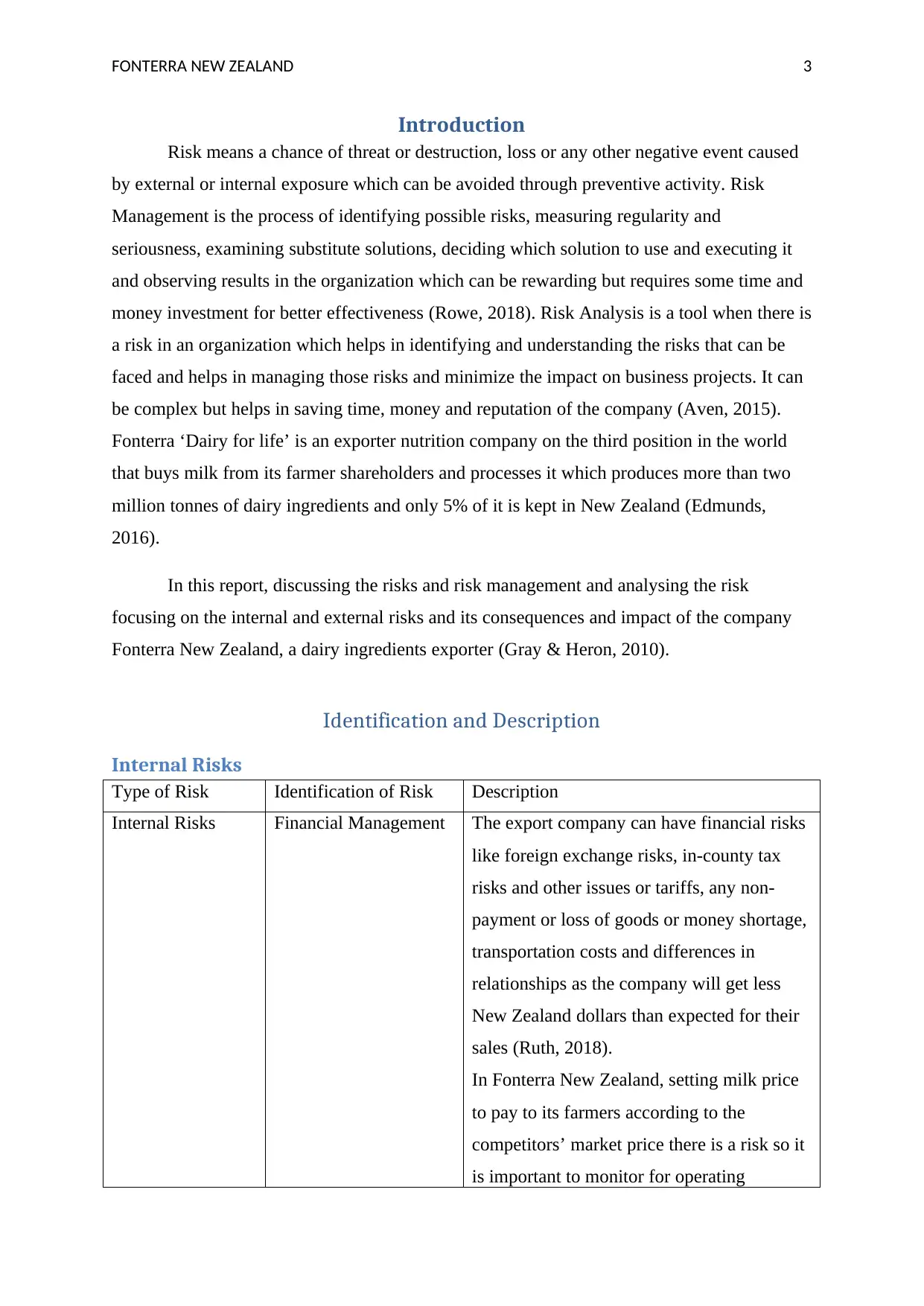
FONTERRA NEW ZEALAND 3
Introduction
Risk means a chance of threat or destruction, loss or any other negative event caused
by external or internal exposure which can be avoided through preventive activity. Risk
Management is the process of identifying possible risks, measuring regularity and
seriousness, examining substitute solutions, deciding which solution to use and executing it
and observing results in the organization which can be rewarding but requires some time and
money investment for better effectiveness (Rowe, 2018). Risk Analysis is a tool when there is
a risk in an organization which helps in identifying and understanding the risks that can be
faced and helps in managing those risks and minimize the impact on business projects. It can
be complex but helps in saving time, money and reputation of the company (Aven, 2015).
Fonterra ‘Dairy for life’ is an exporter nutrition company on the third position in the world
that buys milk from its farmer shareholders and processes it which produces more than two
million tonnes of dairy ingredients and only 5% of it is kept in New Zealand (Edmunds,
2016).
In this report, discussing the risks and risk management and analysing the risk
focusing on the internal and external risks and its consequences and impact of the company
Fonterra New Zealand, a dairy ingredients exporter (Gray & Heron, 2010).
Identification and Description
Internal Risks
Type of Risk Identification of Risk Description
Internal Risks Financial Management The export company can have financial risks
like foreign exchange risks, in-county tax
risks and other issues or tariffs, any non-
payment or loss of goods or money shortage,
transportation costs and differences in
relationships as the company will get less
New Zealand dollars than expected for their
sales (Ruth, 2018).
In Fonterra New Zealand, setting milk price
to pay to its farmers according to the
competitors’ market price there is a risk so it
is important to monitor for operating
Introduction
Risk means a chance of threat or destruction, loss or any other negative event caused
by external or internal exposure which can be avoided through preventive activity. Risk
Management is the process of identifying possible risks, measuring regularity and
seriousness, examining substitute solutions, deciding which solution to use and executing it
and observing results in the organization which can be rewarding but requires some time and
money investment for better effectiveness (Rowe, 2018). Risk Analysis is a tool when there is
a risk in an organization which helps in identifying and understanding the risks that can be
faced and helps in managing those risks and minimize the impact on business projects. It can
be complex but helps in saving time, money and reputation of the company (Aven, 2015).
Fonterra ‘Dairy for life’ is an exporter nutrition company on the third position in the world
that buys milk from its farmer shareholders and processes it which produces more than two
million tonnes of dairy ingredients and only 5% of it is kept in New Zealand (Edmunds,
2016).
In this report, discussing the risks and risk management and analysing the risk
focusing on the internal and external risks and its consequences and impact of the company
Fonterra New Zealand, a dairy ingredients exporter (Gray & Heron, 2010).
Identification and Description
Internal Risks
Type of Risk Identification of Risk Description
Internal Risks Financial Management The export company can have financial risks
like foreign exchange risks, in-county tax
risks and other issues or tariffs, any non-
payment or loss of goods or money shortage,
transportation costs and differences in
relationships as the company will get less
New Zealand dollars than expected for their
sales (Ruth, 2018).
In Fonterra New Zealand, setting milk price
to pay to its farmers according to the
competitors’ market price there is a risk so it
is important to monitor for operating
Paraphrase This Document
Need a fresh take? Get an instant paraphrase of this document with our AI Paraphraser
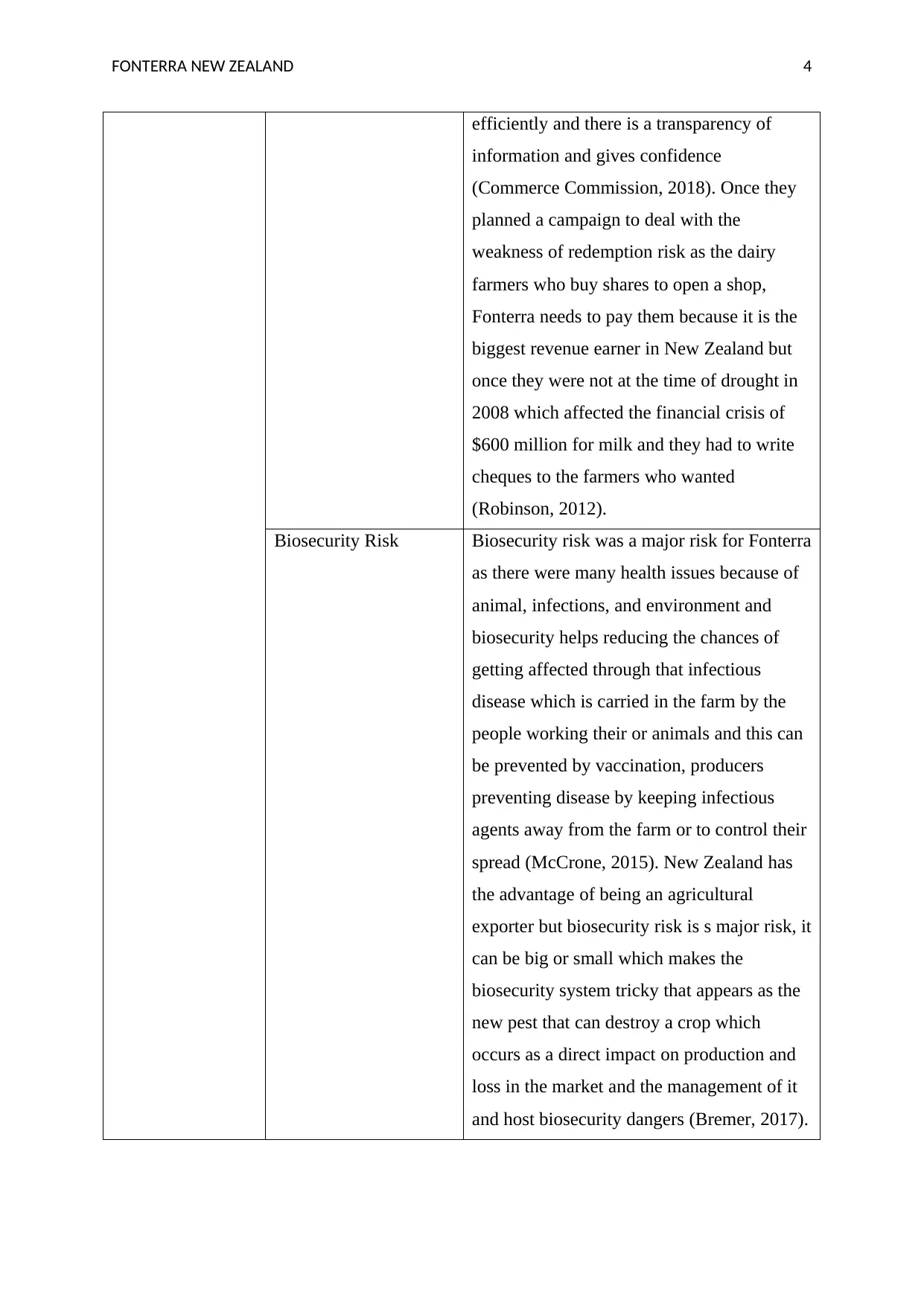
FONTERRA NEW ZEALAND 4
efficiently and there is a transparency of
information and gives confidence
(Commerce Commission, 2018). Once they
planned a campaign to deal with the
weakness of redemption risk as the dairy
farmers who buy shares to open a shop,
Fonterra needs to pay them because it is the
biggest revenue earner in New Zealand but
once they were not at the time of drought in
2008 which affected the financial crisis of
$600 million for milk and they had to write
cheques to the farmers who wanted
(Robinson, 2012).
Biosecurity Risk Biosecurity risk was a major risk for Fonterra
as there were many health issues because of
animal, infections, and environment and
biosecurity helps reducing the chances of
getting affected through that infectious
disease which is carried in the farm by the
people working their or animals and this can
be prevented by vaccination, producers
preventing disease by keeping infectious
agents away from the farm or to control their
spread (McCrone, 2015). New Zealand has
the advantage of being an agricultural
exporter but biosecurity risk is s major risk, it
can be big or small which makes the
biosecurity system tricky that appears as the
new pest that can destroy a crop which
occurs as a direct impact on production and
loss in the market and the management of it
and host biosecurity dangers (Bremer, 2017).
efficiently and there is a transparency of
information and gives confidence
(Commerce Commission, 2018). Once they
planned a campaign to deal with the
weakness of redemption risk as the dairy
farmers who buy shares to open a shop,
Fonterra needs to pay them because it is the
biggest revenue earner in New Zealand but
once they were not at the time of drought in
2008 which affected the financial crisis of
$600 million for milk and they had to write
cheques to the farmers who wanted
(Robinson, 2012).
Biosecurity Risk Biosecurity risk was a major risk for Fonterra
as there were many health issues because of
animal, infections, and environment and
biosecurity helps reducing the chances of
getting affected through that infectious
disease which is carried in the farm by the
people working their or animals and this can
be prevented by vaccination, producers
preventing disease by keeping infectious
agents away from the farm or to control their
spread (McCrone, 2015). New Zealand has
the advantage of being an agricultural
exporter but biosecurity risk is s major risk, it
can be big or small which makes the
biosecurity system tricky that appears as the
new pest that can destroy a crop which
occurs as a direct impact on production and
loss in the market and the management of it
and host biosecurity dangers (Bremer, 2017).
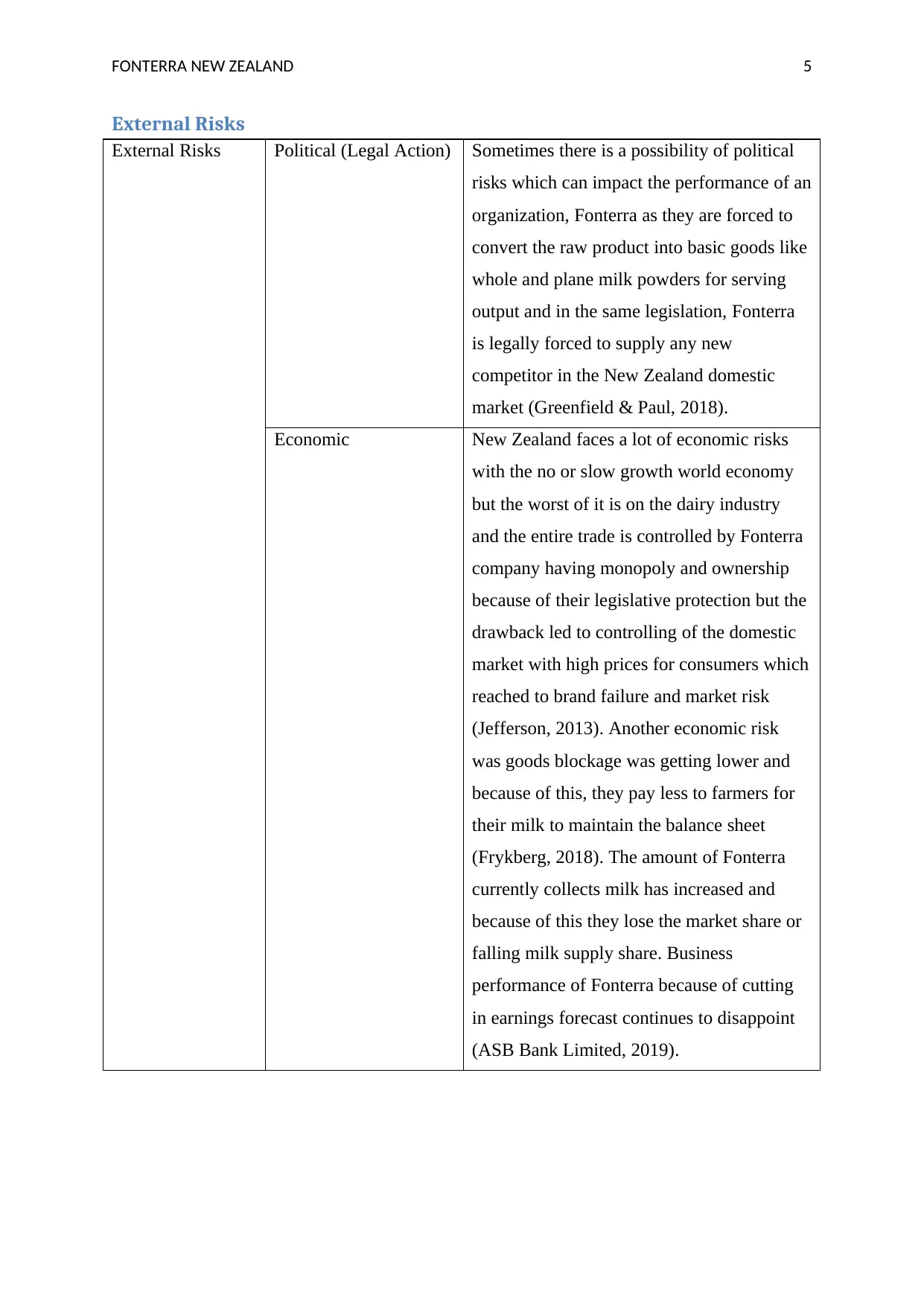
FONTERRA NEW ZEALAND 5
External Risks
External Risks Political (Legal Action) Sometimes there is a possibility of political
risks which can impact the performance of an
organization, Fonterra as they are forced to
convert the raw product into basic goods like
whole and plane milk powders for serving
output and in the same legislation, Fonterra
is legally forced to supply any new
competitor in the New Zealand domestic
market (Greenfield & Paul, 2018).
Economic New Zealand faces a lot of economic risks
with the no or slow growth world economy
but the worst of it is on the dairy industry
and the entire trade is controlled by Fonterra
company having monopoly and ownership
because of their legislative protection but the
drawback led to controlling of the domestic
market with high prices for consumers which
reached to brand failure and market risk
(Jefferson, 2013). Another economic risk
was goods blockage was getting lower and
because of this, they pay less to farmers for
their milk to maintain the balance sheet
(Frykberg, 2018). The amount of Fonterra
currently collects milk has increased and
because of this they lose the market share or
falling milk supply share. Business
performance of Fonterra because of cutting
in earnings forecast continues to disappoint
(ASB Bank Limited, 2019).
External Risks
External Risks Political (Legal Action) Sometimes there is a possibility of political
risks which can impact the performance of an
organization, Fonterra as they are forced to
convert the raw product into basic goods like
whole and plane milk powders for serving
output and in the same legislation, Fonterra
is legally forced to supply any new
competitor in the New Zealand domestic
market (Greenfield & Paul, 2018).
Economic New Zealand faces a lot of economic risks
with the no or slow growth world economy
but the worst of it is on the dairy industry
and the entire trade is controlled by Fonterra
company having monopoly and ownership
because of their legislative protection but the
drawback led to controlling of the domestic
market with high prices for consumers which
reached to brand failure and market risk
(Jefferson, 2013). Another economic risk
was goods blockage was getting lower and
because of this, they pay less to farmers for
their milk to maintain the balance sheet
(Frykberg, 2018). The amount of Fonterra
currently collects milk has increased and
because of this they lose the market share or
falling milk supply share. Business
performance of Fonterra because of cutting
in earnings forecast continues to disappoint
(ASB Bank Limited, 2019).
⊘ This is a preview!⊘
Do you want full access?
Subscribe today to unlock all pages.

Trusted by 1+ million students worldwide
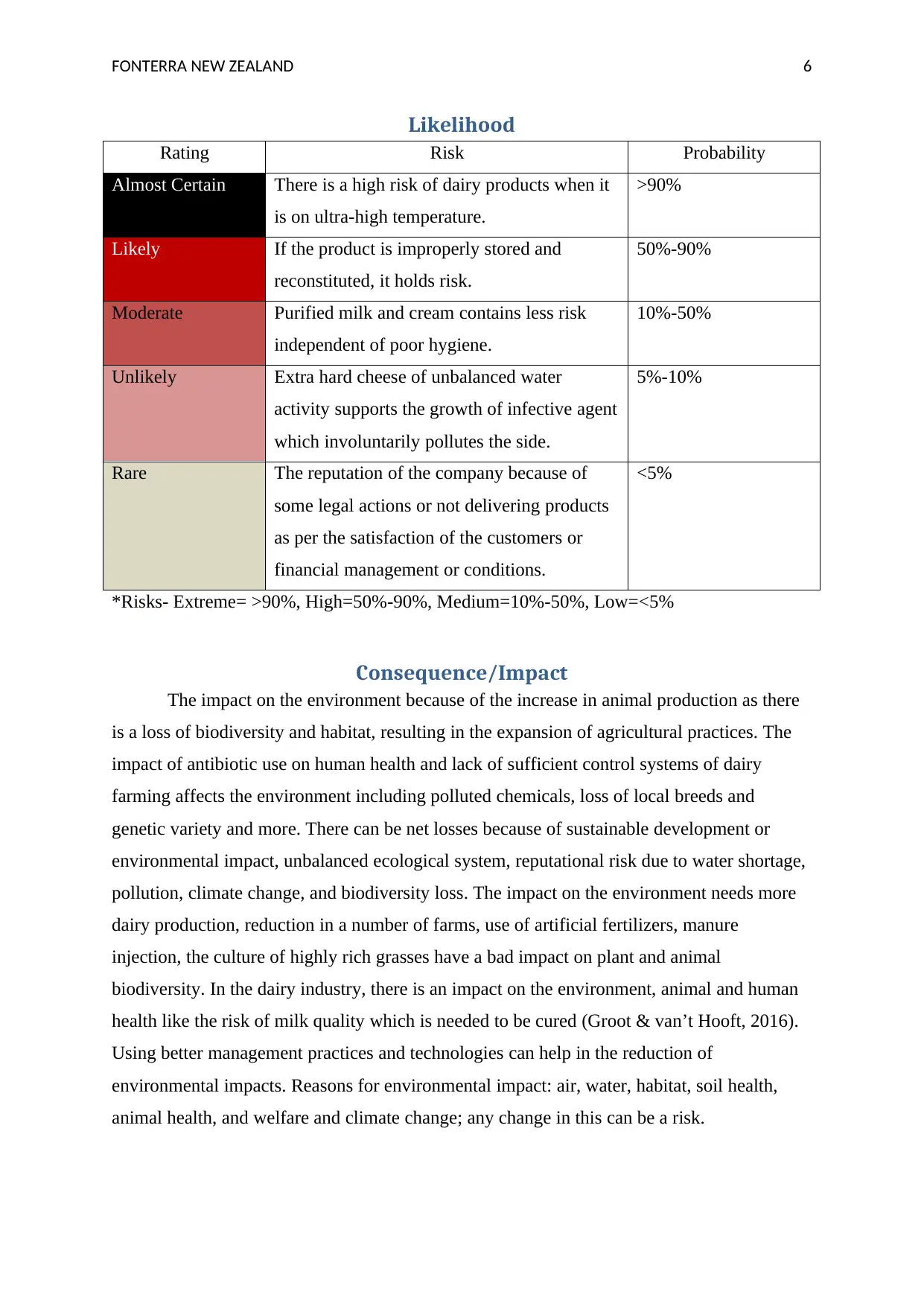
FONTERRA NEW ZEALAND 6
Likelihood
Rating Risk Probability
Almost Certain There is a high risk of dairy products when it
is on ultra-high temperature.
>90%
Likely If the product is improperly stored and
reconstituted, it holds risk.
50%-90%
Moderate Purified milk and cream contains less risk
independent of poor hygiene.
10%-50%
Unlikely Extra hard cheese of unbalanced water
activity supports the growth of infective agent
which involuntarily pollutes the side.
5%-10%
Rare The reputation of the company because of
some legal actions or not delivering products
as per the satisfaction of the customers or
financial management or conditions.
<5%
*Risks- Extreme= >90%, High=50%-90%, Medium=10%-50%, Low=<5%
Consequence/Impact
The impact on the environment because of the increase in animal production as there
is a loss of biodiversity and habitat, resulting in the expansion of agricultural practices. The
impact of antibiotic use on human health and lack of sufficient control systems of dairy
farming affects the environment including polluted chemicals, loss of local breeds and
genetic variety and more. There can be net losses because of sustainable development or
environmental impact, unbalanced ecological system, reputational risk due to water shortage,
pollution, climate change, and biodiversity loss. The impact on the environment needs more
dairy production, reduction in a number of farms, use of artificial fertilizers, manure
injection, the culture of highly rich grasses have a bad impact on plant and animal
biodiversity. In the dairy industry, there is an impact on the environment, animal and human
health like the risk of milk quality which is needed to be cured (Groot & van’t Hooft, 2016).
Using better management practices and technologies can help in the reduction of
environmental impacts. Reasons for environmental impact: air, water, habitat, soil health,
animal health, and welfare and climate change; any change in this can be a risk.
Likelihood
Rating Risk Probability
Almost Certain There is a high risk of dairy products when it
is on ultra-high temperature.
>90%
Likely If the product is improperly stored and
reconstituted, it holds risk.
50%-90%
Moderate Purified milk and cream contains less risk
independent of poor hygiene.
10%-50%
Unlikely Extra hard cheese of unbalanced water
activity supports the growth of infective agent
which involuntarily pollutes the side.
5%-10%
Rare The reputation of the company because of
some legal actions or not delivering products
as per the satisfaction of the customers or
financial management or conditions.
<5%
*Risks- Extreme= >90%, High=50%-90%, Medium=10%-50%, Low=<5%
Consequence/Impact
The impact on the environment because of the increase in animal production as there
is a loss of biodiversity and habitat, resulting in the expansion of agricultural practices. The
impact of antibiotic use on human health and lack of sufficient control systems of dairy
farming affects the environment including polluted chemicals, loss of local breeds and
genetic variety and more. There can be net losses because of sustainable development or
environmental impact, unbalanced ecological system, reputational risk due to water shortage,
pollution, climate change, and biodiversity loss. The impact on the environment needs more
dairy production, reduction in a number of farms, use of artificial fertilizers, manure
injection, the culture of highly rich grasses have a bad impact on plant and animal
biodiversity. In the dairy industry, there is an impact on the environment, animal and human
health like the risk of milk quality which is needed to be cured (Groot & van’t Hooft, 2016).
Using better management practices and technologies can help in the reduction of
environmental impacts. Reasons for environmental impact: air, water, habitat, soil health,
animal health, and welfare and climate change; any change in this can be a risk.
Paraphrase This Document
Need a fresh take? Get an instant paraphrase of this document with our AI Paraphraser
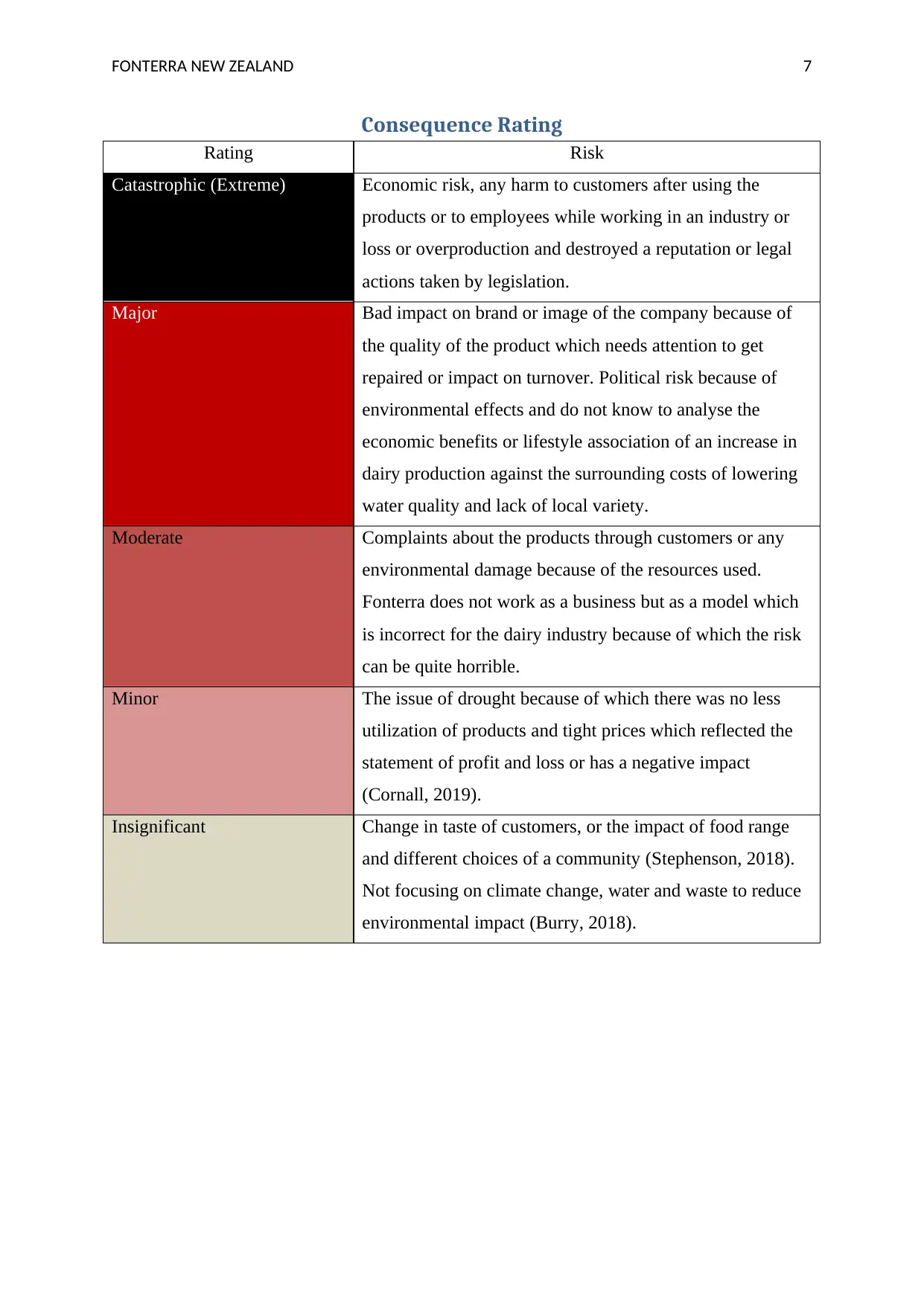
FONTERRA NEW ZEALAND 7
Consequence Rating
Rating Risk
Catastrophic (Extreme) Economic risk, any harm to customers after using the
products or to employees while working in an industry or
loss or overproduction and destroyed a reputation or legal
actions taken by legislation.
Major Bad impact on brand or image of the company because of
the quality of the product which needs attention to get
repaired or impact on turnover. Political risk because of
environmental effects and do not know to analyse the
economic benefits or lifestyle association of an increase in
dairy production against the surrounding costs of lowering
water quality and lack of local variety.
Moderate Complaints about the products through customers or any
environmental damage because of the resources used.
Fonterra does not work as a business but as a model which
is incorrect for the dairy industry because of which the risk
can be quite horrible.
Minor The issue of drought because of which there was no less
utilization of products and tight prices which reflected the
statement of profit and loss or has a negative impact
(Cornall, 2019).
Insignificant Change in taste of customers, or the impact of food range
and different choices of a community (Stephenson, 2018).
Not focusing on climate change, water and waste to reduce
environmental impact (Burry, 2018).
Consequence Rating
Rating Risk
Catastrophic (Extreme) Economic risk, any harm to customers after using the
products or to employees while working in an industry or
loss or overproduction and destroyed a reputation or legal
actions taken by legislation.
Major Bad impact on brand or image of the company because of
the quality of the product which needs attention to get
repaired or impact on turnover. Political risk because of
environmental effects and do not know to analyse the
economic benefits or lifestyle association of an increase in
dairy production against the surrounding costs of lowering
water quality and lack of local variety.
Moderate Complaints about the products through customers or any
environmental damage because of the resources used.
Fonterra does not work as a business but as a model which
is incorrect for the dairy industry because of which the risk
can be quite horrible.
Minor The issue of drought because of which there was no less
utilization of products and tight prices which reflected the
statement of profit and loss or has a negative impact
(Cornall, 2019).
Insignificant Change in taste of customers, or the impact of food range
and different choices of a community (Stephenson, 2018).
Not focusing on climate change, water and waste to reduce
environmental impact (Burry, 2018).
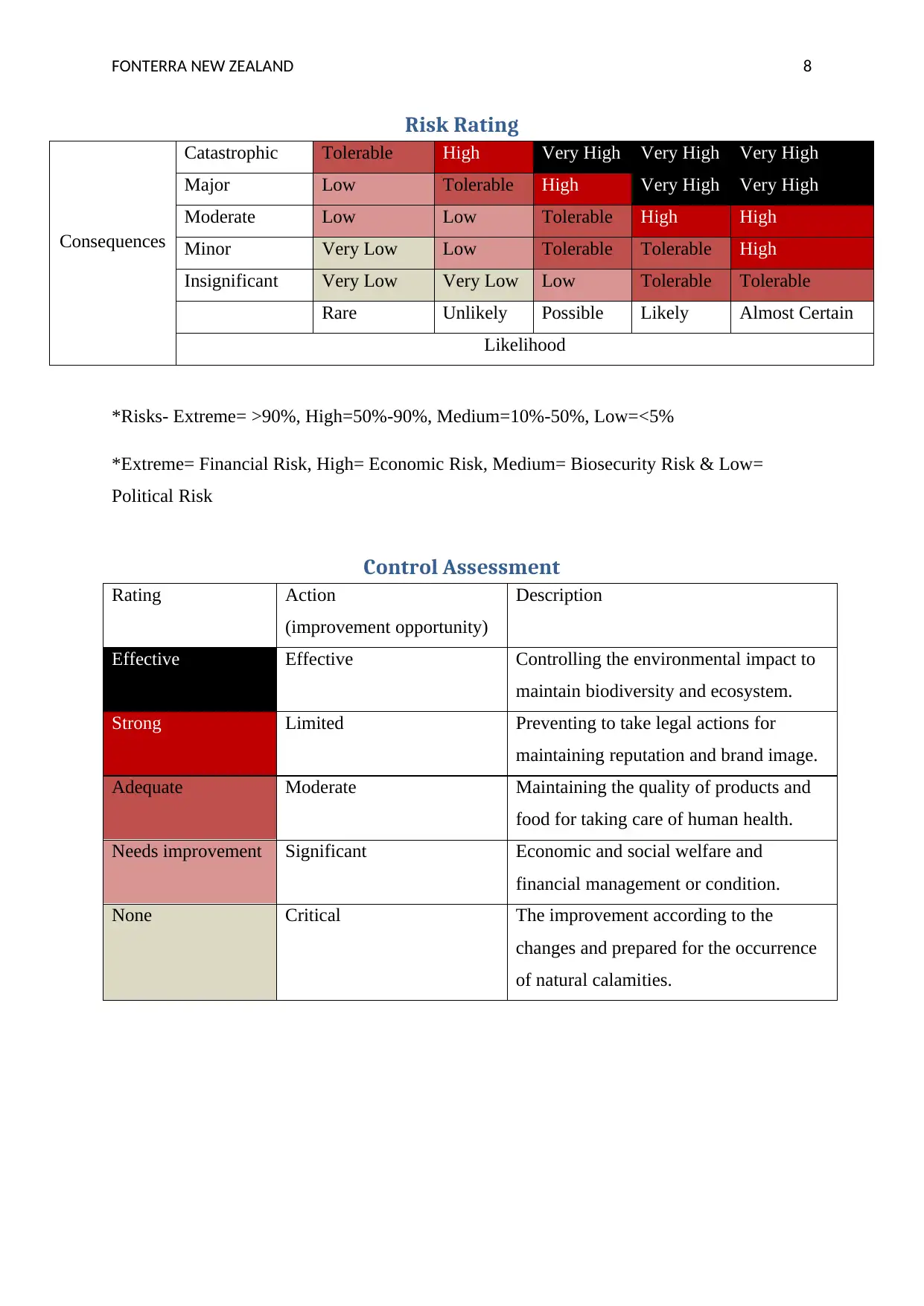
FONTERRA NEW ZEALAND 8
Risk Rating
Consequences
Catastrophic Tolerable High Very High Very High Very High
Major Low Tolerable High Very High Very High
Moderate Low Low Tolerable High High
Minor Very Low Low Tolerable Tolerable High
Insignificant Very Low Very Low Low Tolerable Tolerable
Rare Unlikely Possible Likely Almost Certain
Likelihood
*Risks- Extreme= >90%, High=50%-90%, Medium=10%-50%, Low=<5%
*Extreme= Financial Risk, High= Economic Risk, Medium= Biosecurity Risk & Low=
Political Risk
Control Assessment
Rating Action
(improvement opportunity)
Description
Effective Effective Controlling the environmental impact to
maintain biodiversity and ecosystem.
Strong Limited Preventing to take legal actions for
maintaining reputation and brand image.
Adequate Moderate Maintaining the quality of products and
food for taking care of human health.
Needs improvement Significant Economic and social welfare and
financial management or condition.
None Critical The improvement according to the
changes and prepared for the occurrence
of natural calamities.
Risk Rating
Consequences
Catastrophic Tolerable High Very High Very High Very High
Major Low Tolerable High Very High Very High
Moderate Low Low Tolerable High High
Minor Very Low Low Tolerable Tolerable High
Insignificant Very Low Very Low Low Tolerable Tolerable
Rare Unlikely Possible Likely Almost Certain
Likelihood
*Risks- Extreme= >90%, High=50%-90%, Medium=10%-50%, Low=<5%
*Extreme= Financial Risk, High= Economic Risk, Medium= Biosecurity Risk & Low=
Political Risk
Control Assessment
Rating Action
(improvement opportunity)
Description
Effective Effective Controlling the environmental impact to
maintain biodiversity and ecosystem.
Strong Limited Preventing to take legal actions for
maintaining reputation and brand image.
Adequate Moderate Maintaining the quality of products and
food for taking care of human health.
Needs improvement Significant Economic and social welfare and
financial management or condition.
None Critical The improvement according to the
changes and prepared for the occurrence
of natural calamities.
⊘ This is a preview!⊘
Do you want full access?
Subscribe today to unlock all pages.

Trusted by 1+ million students worldwide
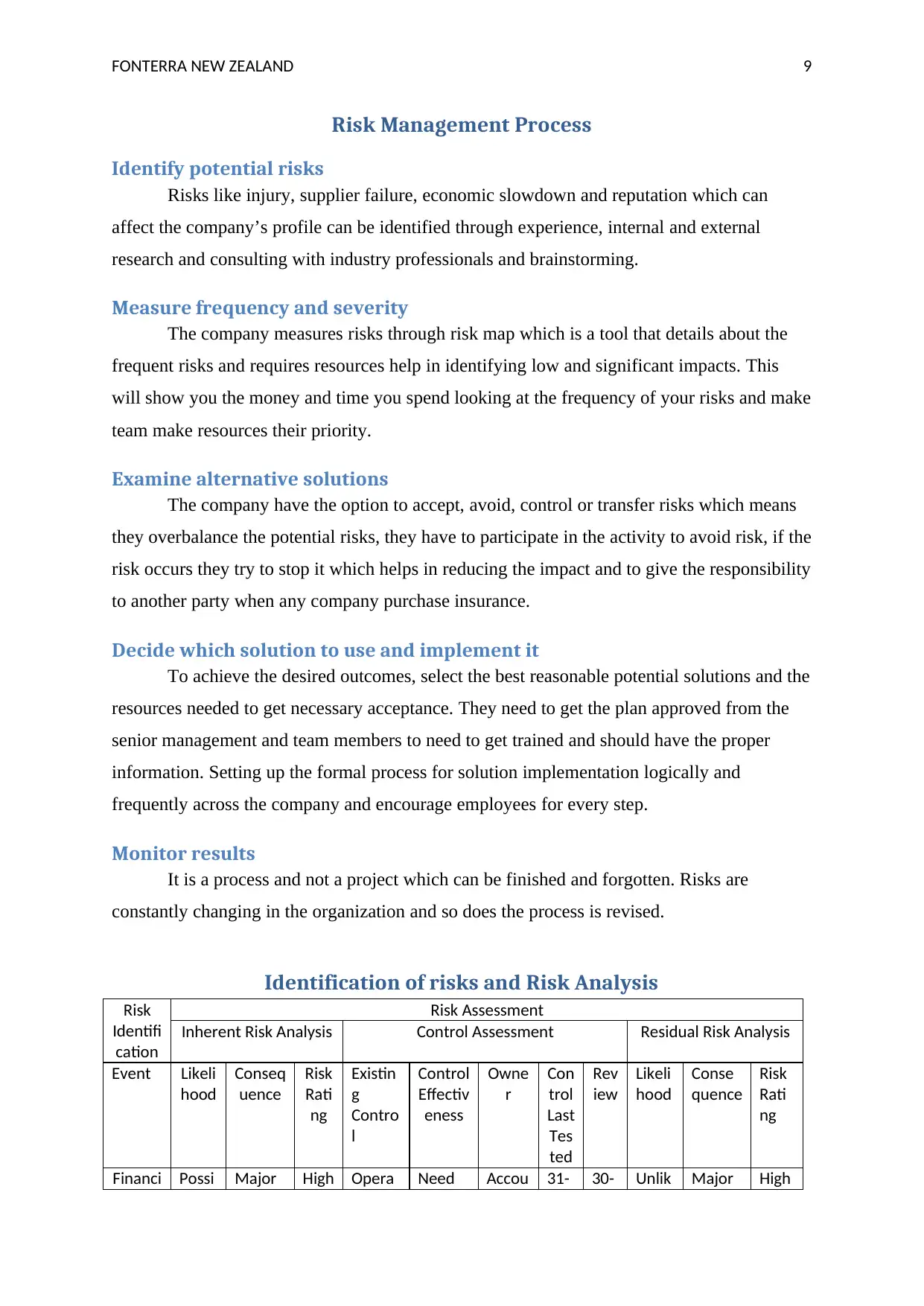
FONTERRA NEW ZEALAND 9
Risk Management Process
Identify potential risks
Risks like injury, supplier failure, economic slowdown and reputation which can
affect the company’s profile can be identified through experience, internal and external
research and consulting with industry professionals and brainstorming.
Measure frequency and severity
The company measures risks through risk map which is a tool that details about the
frequent risks and requires resources help in identifying low and significant impacts. This
will show you the money and time you spend looking at the frequency of your risks and make
team make resources their priority.
Examine alternative solutions
The company have the option to accept, avoid, control or transfer risks which means
they overbalance the potential risks, they have to participate in the activity to avoid risk, if the
risk occurs they try to stop it which helps in reducing the impact and to give the responsibility
to another party when any company purchase insurance.
Decide which solution to use and implement it
To achieve the desired outcomes, select the best reasonable potential solutions and the
resources needed to get necessary acceptance. They need to get the plan approved from the
senior management and team members to need to get trained and should have the proper
information. Setting up the formal process for solution implementation logically and
frequently across the company and encourage employees for every step.
Monitor results
It is a process and not a project which can be finished and forgotten. Risks are
constantly changing in the organization and so does the process is revised.
Identification of risks and Risk Analysis
Risk
Identifi
cation
Risk Assessment
Inherent Risk Analysis Control Assessment Residual Risk Analysis
Event Likeli
hood
Conseq
uence
Risk
Rati
ng
Existin
g
Contro
l
Control
Effectiv
eness
Owne
r
Con
trol
Last
Tes
ted
Rev
iew
Likeli
hood
Conse
quence
Risk
Rati
ng
Financi Possi Major High Opera Need Accou 31- 30- Unlik Major High
Risk Management Process
Identify potential risks
Risks like injury, supplier failure, economic slowdown and reputation which can
affect the company’s profile can be identified through experience, internal and external
research and consulting with industry professionals and brainstorming.
Measure frequency and severity
The company measures risks through risk map which is a tool that details about the
frequent risks and requires resources help in identifying low and significant impacts. This
will show you the money and time you spend looking at the frequency of your risks and make
team make resources their priority.
Examine alternative solutions
The company have the option to accept, avoid, control or transfer risks which means
they overbalance the potential risks, they have to participate in the activity to avoid risk, if the
risk occurs they try to stop it which helps in reducing the impact and to give the responsibility
to another party when any company purchase insurance.
Decide which solution to use and implement it
To achieve the desired outcomes, select the best reasonable potential solutions and the
resources needed to get necessary acceptance. They need to get the plan approved from the
senior management and team members to need to get trained and should have the proper
information. Setting up the formal process for solution implementation logically and
frequently across the company and encourage employees for every step.
Monitor results
It is a process and not a project which can be finished and forgotten. Risks are
constantly changing in the organization and so does the process is revised.
Identification of risks and Risk Analysis
Risk
Identifi
cation
Risk Assessment
Inherent Risk Analysis Control Assessment Residual Risk Analysis
Event Likeli
hood
Conseq
uence
Risk
Rati
ng
Existin
g
Contro
l
Control
Effectiv
eness
Owne
r
Con
trol
Last
Tes
ted
Rev
iew
Likeli
hood
Conse
quence
Risk
Rati
ng
Financi Possi Major High Opera Need Accou 31- 30- Unlik Major High
Paraphrase This Document
Need a fresh take? Get an instant paraphrase of this document with our AI Paraphraser
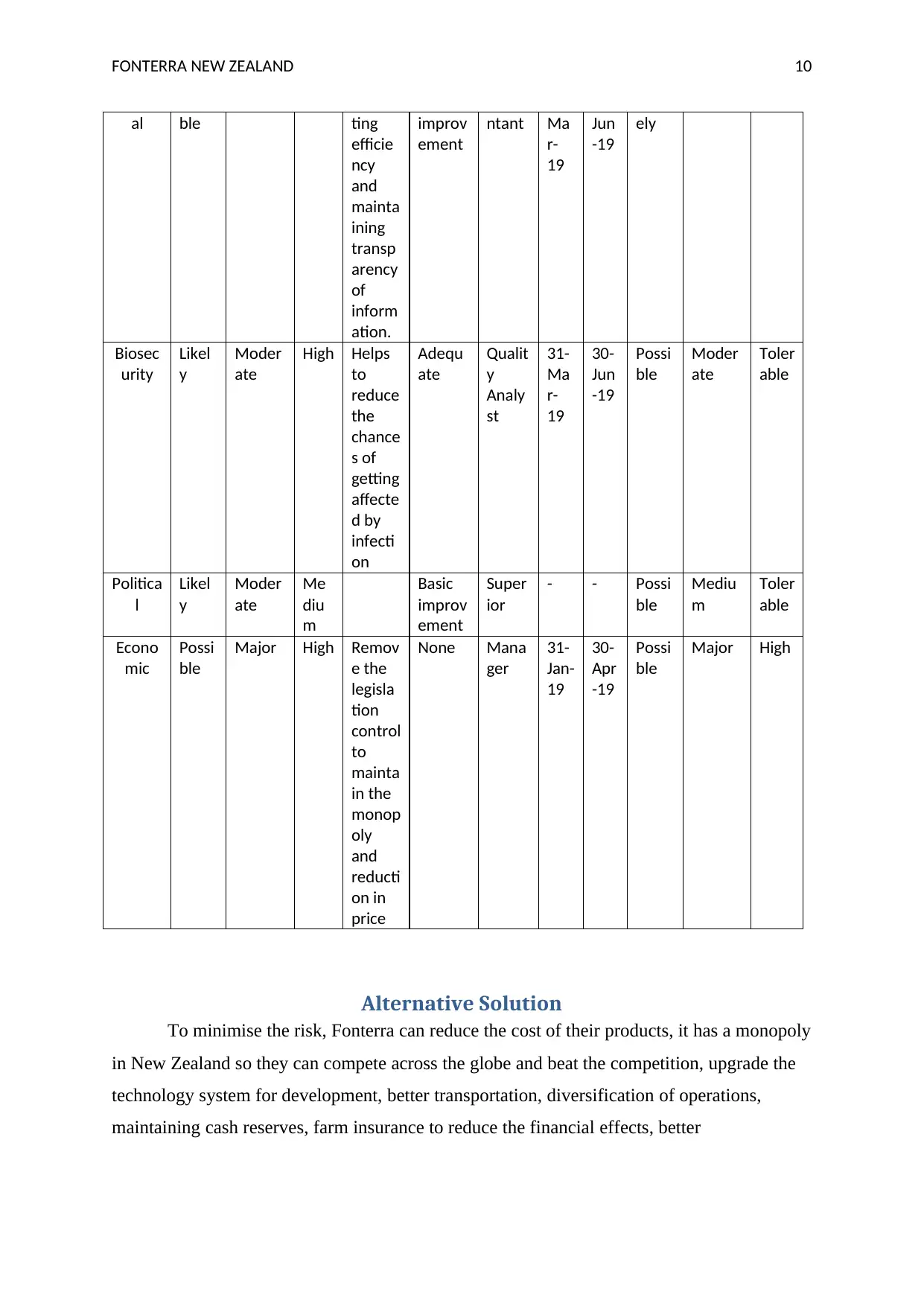
FONTERRA NEW ZEALAND 10
al ble ting
efficie
ncy
and
mainta
ining
transp
arency
of
inform
ation.
improv
ement
ntant Ma
r-
19
Jun
-19
ely
Biosec
urity
Likel
y
Moder
ate
High Helps
to
reduce
the
chance
s of
getting
affecte
d by
infecti
on
Adequ
ate
Qualit
y
Analy
st
31-
Ma
r-
19
30-
Jun
-19
Possi
ble
Moder
ate
Toler
able
Politica
l
Likel
y
Moder
ate
Me
diu
m
Basic
improv
ement
Super
ior
- - Possi
ble
Mediu
m
Toler
able
Econo
mic
Possi
ble
Major High Remov
e the
legisla
tion
control
to
mainta
in the
monop
oly
and
reducti
on in
price
None Mana
ger
31-
Jan-
19
30-
Apr
-19
Possi
ble
Major High
Alternative Solution
To minimise the risk, Fonterra can reduce the cost of their products, it has a monopoly
in New Zealand so they can compete across the globe and beat the competition, upgrade the
technology system for development, better transportation, diversification of operations,
maintaining cash reserves, farm insurance to reduce the financial effects, better
al ble ting
efficie
ncy
and
mainta
ining
transp
arency
of
inform
ation.
improv
ement
ntant Ma
r-
19
Jun
-19
ely
Biosec
urity
Likel
y
Moder
ate
High Helps
to
reduce
the
chance
s of
getting
affecte
d by
infecti
on
Adequ
ate
Qualit
y
Analy
st
31-
Ma
r-
19
30-
Jun
-19
Possi
ble
Moder
ate
Toler
able
Politica
l
Likel
y
Moder
ate
Me
diu
m
Basic
improv
ement
Super
ior
- - Possi
ble
Mediu
m
Toler
able
Econo
mic
Possi
ble
Major High Remov
e the
legisla
tion
control
to
mainta
in the
monop
oly
and
reducti
on in
price
None Mana
ger
31-
Jan-
19
30-
Apr
-19
Possi
ble
Major High
Alternative Solution
To minimise the risk, Fonterra can reduce the cost of their products, it has a monopoly
in New Zealand so they can compete across the globe and beat the competition, upgrade the
technology system for development, better transportation, diversification of operations,
maintaining cash reserves, farm insurance to reduce the financial effects, better
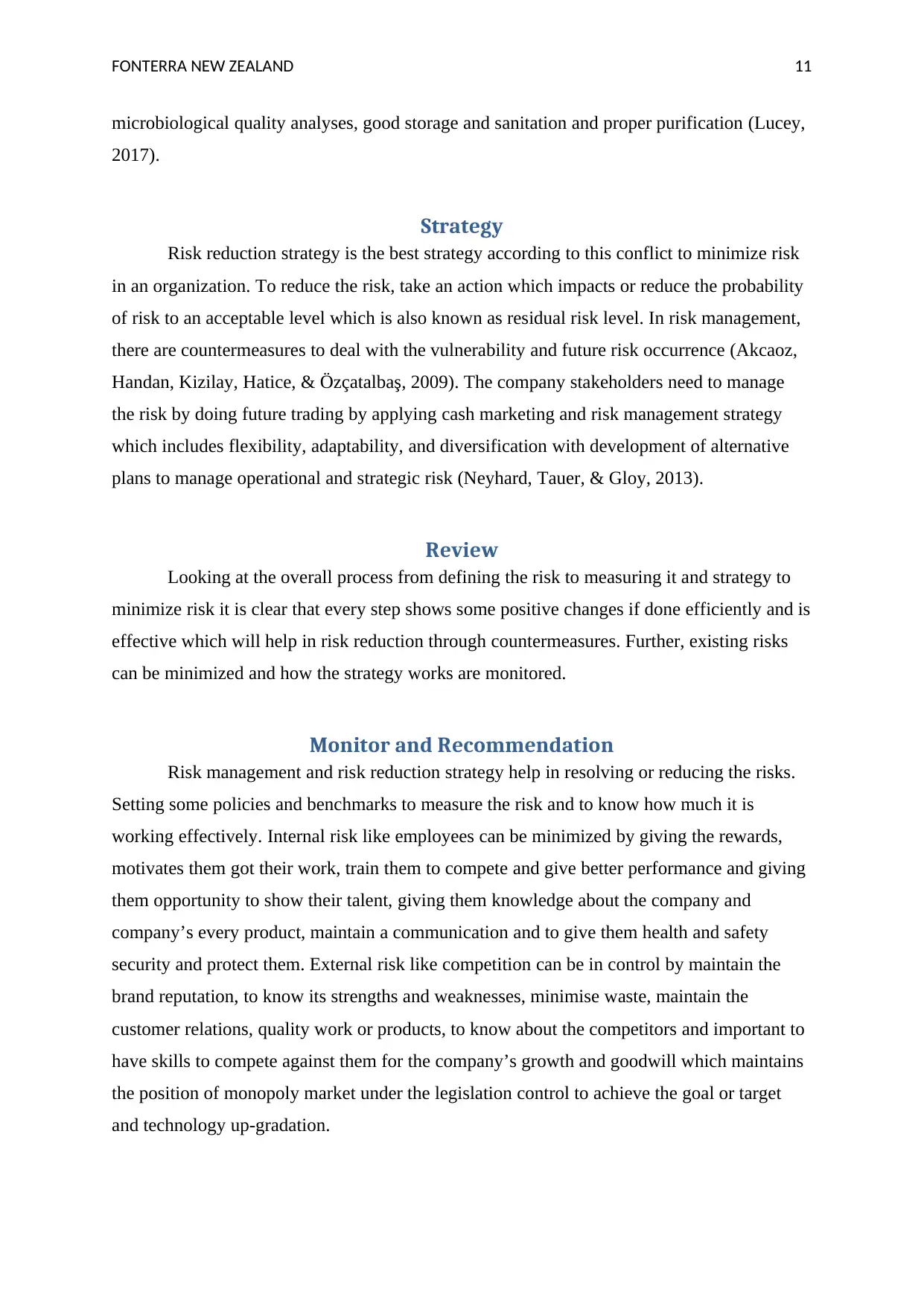
FONTERRA NEW ZEALAND 11
microbiological quality analyses, good storage and sanitation and proper purification (Lucey,
2017).
Strategy
Risk reduction strategy is the best strategy according to this conflict to minimize risk
in an organization. To reduce the risk, take an action which impacts or reduce the probability
of risk to an acceptable level which is also known as residual risk level. In risk management,
there are countermeasures to deal with the vulnerability and future risk occurrence (Akcaoz,
Handan, Kizilay, Hatice, & Özçatalbaş, 2009). The company stakeholders need to manage
the risk by doing future trading by applying cash marketing and risk management strategy
which includes flexibility, adaptability, and diversification with development of alternative
plans to manage operational and strategic risk (Neyhard, Tauer, & Gloy, 2013).
Review
Looking at the overall process from defining the risk to measuring it and strategy to
minimize risk it is clear that every step shows some positive changes if done efficiently and is
effective which will help in risk reduction through countermeasures. Further, existing risks
can be minimized and how the strategy works are monitored.
Monitor and Recommendation
Risk management and risk reduction strategy help in resolving or reducing the risks.
Setting some policies and benchmarks to measure the risk and to know how much it is
working effectively. Internal risk like employees can be minimized by giving the rewards,
motivates them got their work, train them to compete and give better performance and giving
them opportunity to show their talent, giving them knowledge about the company and
company’s every product, maintain a communication and to give them health and safety
security and protect them. External risk like competition can be in control by maintain the
brand reputation, to know its strengths and weaknesses, minimise waste, maintain the
customer relations, quality work or products, to know about the competitors and important to
have skills to compete against them for the company’s growth and goodwill which maintains
the position of monopoly market under the legislation control to achieve the goal or target
and technology up-gradation.
microbiological quality analyses, good storage and sanitation and proper purification (Lucey,
2017).
Strategy
Risk reduction strategy is the best strategy according to this conflict to minimize risk
in an organization. To reduce the risk, take an action which impacts or reduce the probability
of risk to an acceptable level which is also known as residual risk level. In risk management,
there are countermeasures to deal with the vulnerability and future risk occurrence (Akcaoz,
Handan, Kizilay, Hatice, & Özçatalbaş, 2009). The company stakeholders need to manage
the risk by doing future trading by applying cash marketing and risk management strategy
which includes flexibility, adaptability, and diversification with development of alternative
plans to manage operational and strategic risk (Neyhard, Tauer, & Gloy, 2013).
Review
Looking at the overall process from defining the risk to measuring it and strategy to
minimize risk it is clear that every step shows some positive changes if done efficiently and is
effective which will help in risk reduction through countermeasures. Further, existing risks
can be minimized and how the strategy works are monitored.
Monitor and Recommendation
Risk management and risk reduction strategy help in resolving or reducing the risks.
Setting some policies and benchmarks to measure the risk and to know how much it is
working effectively. Internal risk like employees can be minimized by giving the rewards,
motivates them got their work, train them to compete and give better performance and giving
them opportunity to show their talent, giving them knowledge about the company and
company’s every product, maintain a communication and to give them health and safety
security and protect them. External risk like competition can be in control by maintain the
brand reputation, to know its strengths and weaknesses, minimise waste, maintain the
customer relations, quality work or products, to know about the competitors and important to
have skills to compete against them for the company’s growth and goodwill which maintains
the position of monopoly market under the legislation control to achieve the goal or target
and technology up-gradation.
⊘ This is a preview!⊘
Do you want full access?
Subscribe today to unlock all pages.

Trusted by 1+ million students worldwide
1 out of 15
Related Documents
Your All-in-One AI-Powered Toolkit for Academic Success.
+13062052269
info@desklib.com
Available 24*7 on WhatsApp / Email
![[object Object]](/_next/static/media/star-bottom.7253800d.svg)
Unlock your academic potential
Copyright © 2020–2025 A2Z Services. All Rights Reserved. Developed and managed by ZUCOL.





